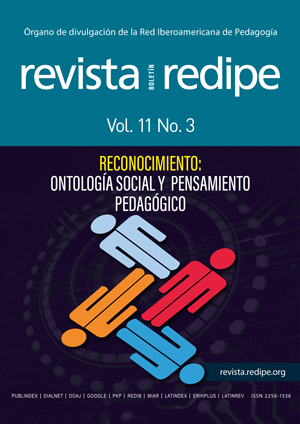Origen de la Escuela Matemática de Varsovia
##plugins.themes.bootstrap3.article.main##
Keywords
Matemática polaca, Teoría de conjuntos, Fundamenta mathematicae, Periodo entreguerras
Resumen
Se presenta un recuento del surgir de la Escuela Matemática de Varsovia, en el periodo Entreguerras (1918-1939), la cual pasó de ser periferia a ser centro de investigación matemática de punta en teoría de conjuntos y ramas cercanas. También se añade puntos para la discusión de la idea de especializar la Escuela en teoría de conjuntos a través de Fundamenta Mathematicae.
Referencias
Arboleda, L. (1982). Elementos inéditos sobre la creación de la escuela polaca de matemáticas. Lecturas Matemáticas, 3, pp. 221-256.
Cerón, A. (2017). Aspectos históricos de la internacionalización de la matemática polaca: 1918-1939. Trabajo de pregrado, Universidad de Nariño.
Chaves, A. (2014). La teoría de conjuntos en el periodo Entreguerras: la internacionalización de la matemática polaca a través de Fundamenta Mathematicae y Sierpiński. Tesis de doctorado, (UAB - UB) Historia de la Ciencia: Ciencia, Historia y Sociedad.
Ciesielski, K. y Moslehian, M. (2010). Some Remarks on the History of Functional Analysis. Annals of Functional Analysis, 1, pp. 1-12. Cominicatted by L. Székelyhidi.
Duda, R. (1996). L’ Europe mathématique / Mathematical Europe, Capítulo: Fundamenta Mathematicae and the Warsaw School of Mathematics, pp. 480-498. Editions de la Maison des sciences de l’homme, Paris.
Hartman, S., Kuratowski, K., Marczewski, E., Mostowski, A., Schinzel, A., Sikorski, R., y Stark, M. (1974). Euvres choisies. Waclaw Sierpinski. Académie Polonaise des Sciences, Institut Mathématique.
Janiszewski, Z. (1918). Sobre las necesidades de las matemáticas en Polonia. En (Arboleda, 1982, Apéndice B), pp. 11{18. Traducido del inglés On the needs of science in Poland por Diego Pareja, en (Kuzawa, 1968, pp. 112-118).
Kowalski, J. (2004). The Polish Mathematical Society (PTM). European Mathematical Society, pp. 24-29.
Kuratowski, K. (1980). A half Century of Polish Mathematics. Pergamon Press. Polish Scientific Publishers. Warsawa. Traducido de polaco a inglés por Andrzej Kirkor. Editor de traducción: Marc E. Heine.
Kuzawa, M. (1968). Modern Mathematics: The Genesis of a School in Poland. College and University Press, New Haven.
Lebesgue, H. (1922). A propos d’ une nouvelle revue mathématique “Fundamenta Mathematicae”. Bull. Sc. Math., 46, pp. 1-13.
Miranowicz, A. y Jakimowicz, E. (2012). Home Page of Stefan Banach. Disponible en http://kielich.amu.edu.pl/Stefan Banach/ e-index.html.
Sierpiński, W. (1963) “Polish School of Mathematics”, Polish Perspectives, 6(8):25-35.
Tamarkin, J. (1936). Twenty-five volumes of Fundamenta Mathematicae. Bulletin of the American Mathematical Society, 42(5), pp. 300.
Ulam, S. (2002). Aventuras de un matemático. Memorias de Stanislaw Ulam. Nivola. Traducción y notas de Ricardo GarcíaPelayo Novo.
Zelazco, W. (2004). A Short History of Polish Mathematics. En Proceedings of the Workshop on Operator Theory and Operator Algebras, Kanagawa University, Yokohama, pp. 105-112. Disponible en: http://www.impan.pl/ Sixty/polmat.pdf.
Cerón, A. (2017). Aspectos históricos de la internacionalización de la matemática polaca: 1918-1939. Trabajo de pregrado, Universidad de Nariño.
Chaves, A. (2014). La teoría de conjuntos en el periodo Entreguerras: la internacionalización de la matemática polaca a través de Fundamenta Mathematicae y Sierpiński. Tesis de doctorado, (UAB - UB) Historia de la Ciencia: Ciencia, Historia y Sociedad.
Ciesielski, K. y Moslehian, M. (2010). Some Remarks on the History of Functional Analysis. Annals of Functional Analysis, 1, pp. 1-12. Cominicatted by L. Székelyhidi.
Duda, R. (1996). L’ Europe mathématique / Mathematical Europe, Capítulo: Fundamenta Mathematicae and the Warsaw School of Mathematics, pp. 480-498. Editions de la Maison des sciences de l’homme, Paris.
Hartman, S., Kuratowski, K., Marczewski, E., Mostowski, A., Schinzel, A., Sikorski, R., y Stark, M. (1974). Euvres choisies. Waclaw Sierpinski. Académie Polonaise des Sciences, Institut Mathématique.
Janiszewski, Z. (1918). Sobre las necesidades de las matemáticas en Polonia. En (Arboleda, 1982, Apéndice B), pp. 11{18. Traducido del inglés On the needs of science in Poland por Diego Pareja, en (Kuzawa, 1968, pp. 112-118).
Kowalski, J. (2004). The Polish Mathematical Society (PTM). European Mathematical Society, pp. 24-29.
Kuratowski, K. (1980). A half Century of Polish Mathematics. Pergamon Press. Polish Scientific Publishers. Warsawa. Traducido de polaco a inglés por Andrzej Kirkor. Editor de traducción: Marc E. Heine.
Kuzawa, M. (1968). Modern Mathematics: The Genesis of a School in Poland. College and University Press, New Haven.
Lebesgue, H. (1922). A propos d’ une nouvelle revue mathématique “Fundamenta Mathematicae”. Bull. Sc. Math., 46, pp. 1-13.
Miranowicz, A. y Jakimowicz, E. (2012). Home Page of Stefan Banach. Disponible en http://kielich.amu.edu.pl/Stefan Banach/ e-index.html.
Sierpiński, W. (1963) “Polish School of Mathematics”, Polish Perspectives, 6(8):25-35.
Tamarkin, J. (1936). Twenty-five volumes of Fundamenta Mathematicae. Bulletin of the American Mathematical Society, 42(5), pp. 300.
Ulam, S. (2002). Aventuras de un matemático. Memorias de Stanislaw Ulam. Nivola. Traducción y notas de Ricardo GarcíaPelayo Novo.
Zelazco, W. (2004). A Short History of Polish Mathematics. En Proceedings of the Workshop on Operator Theory and Operator Algebras, Kanagawa University, Yokohama, pp. 105-112. Disponible en: http://www.impan.pl/ Sixty/polmat.pdf.



